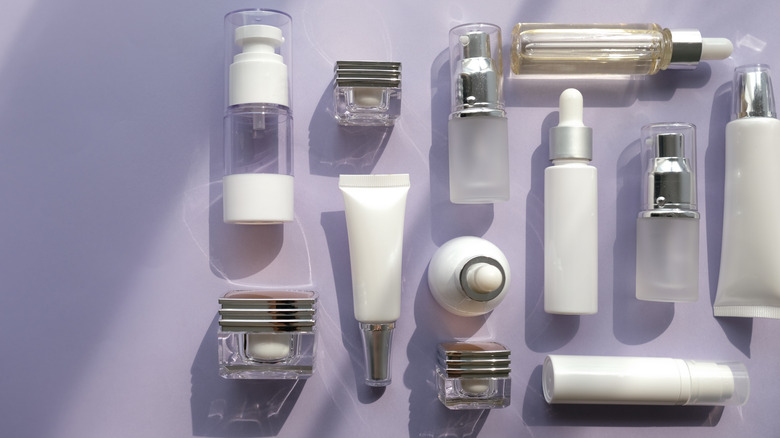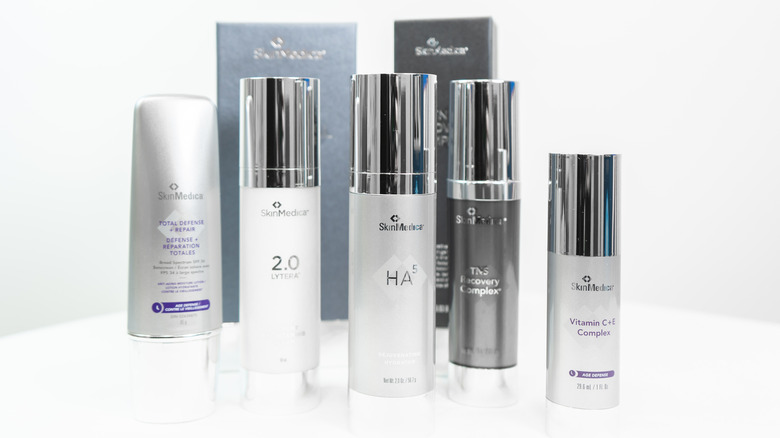The Real Difference Between Medical-Grade Skincare And OTC Products
Inflation is driving the cost of everything up these days, from gasoline to eggs and beyond. This has many people wondering if it's worth it to drop extra pennies on medical-grade skincare when there are so many less expensive over-the-counter options out there. The skincare industry is big business, and it's set to jump from a worldwide valuation of $100.13 billion in 2021 to $145.82 billion in 2028, according to Fortune Business Insights. That's a whole lot of creams, cleansers, and wrinkle reducers.
Indeed, skin issues don't go away as we age so much as they simply change in nature. Acne and oily skin are common in the teens and early 20s, but as hormones fluctuate and change, it's not unusual to experience breakouts much later. The 40s and 50s, however, usually result in some unwelcome changes, like skin that's less elastic and supple, which often results in wrinkles, sagging, and fine lines. Skin also literally gets thinner, and it's not unusual at all for age spots to pop up, especially in areas that are often exposed to the sun, says MedlinePlus. This leaves men and women scrambling to find the best product at the best price to reverse problematic skin issues.
Here's how medical-grade skincare is extra
Skincare products seem to be a situation where you get what you pay for. That's not to say that over-the-counter options are bad, but that medical-grade products simply go above and beyond, which is why they're usually priced in the hundreds of dollars. Medical-grade skincare has a much higher concentration of the active ingredient, compared with any given OTC product, as explained by plastic surgeon Dr. Adam H. Hamawy. This is a big part of what makes them more expensive. "A higher amount of the active ingredient usually equates to better-looking skin," he explains on his blog.
Medical-grade skincare products also typically have better quality active ingredients than OTC products. The latter has some active ingredients in them, but they're often less pure and less well-made than their medical-grade counterparts. Naturally, products with more and better ingredients, like retinol or salicylic acid, are going to cost more than watered-down versions. Plus, there are simply not as many filler ingredients taking up space in a medical-grade bottle as there are in an OTC product.
It's also a question of regulation
You might already know that labels are deceiving. For example, food and products labeled as organic are regulated to meet certain standards, but the word "natural" has no such stringent requirements to meet, according to the American Society for Nutrition. It's sort of the same for skincare products.
As pharmaceutical products, medical-grade skincare is strictly regulated by the Food & Drug Administration to meet certain standards for both effectiveness and safety. So, if a product says it reduces fine lines by altering the body's structure, it should have proof to back it up, usually via clinical trials. Over-the-counter skincare products, however, have no such requirements. For example, products that simply moisturize or perform other surface-level cosmetic tasks are not considered pharmaceutical, so they're not regulated in the same way.
Lastly, the other major difference between OTC and medical-grade skincare is how they are purchased. OTC products can be bought at any number of retail establishments, including your corner drugstore. Medical-grade items with all their concentrated goodness, however, are typically bought at dermatology offices or online. There are some prescription-only acne and other medications that require a prescription, but those are next level and don't fall into either category.


